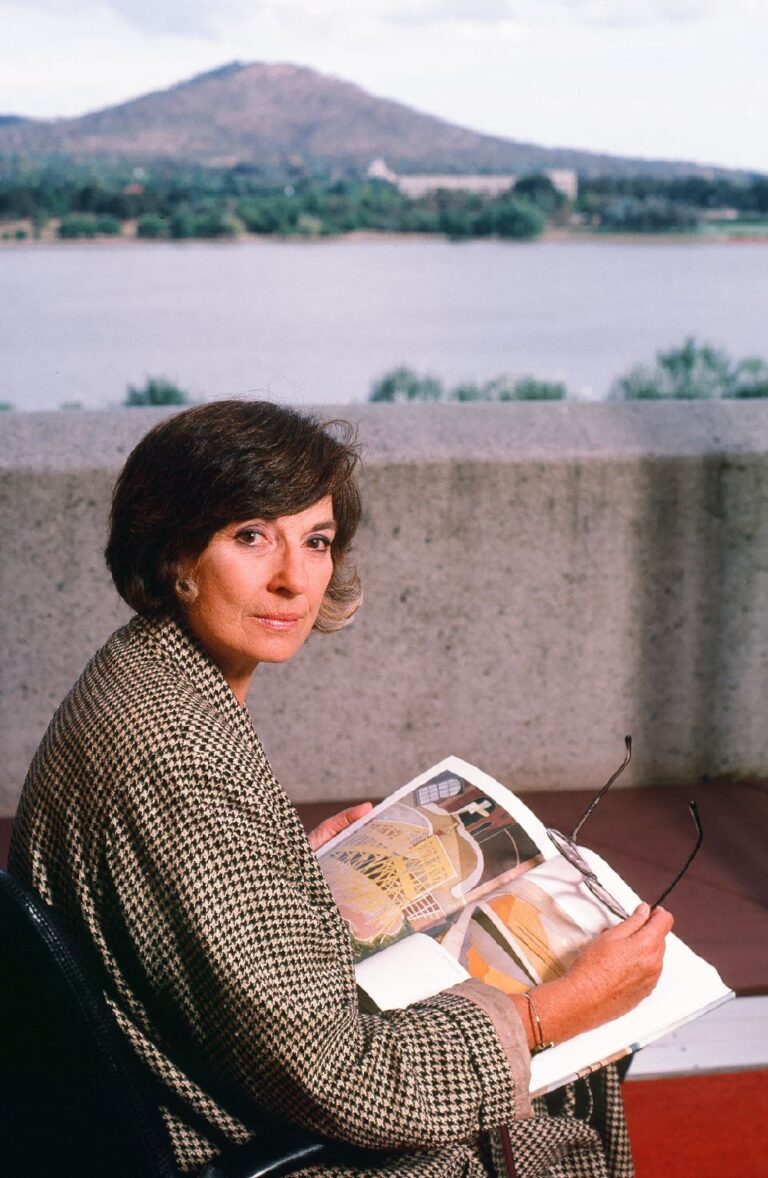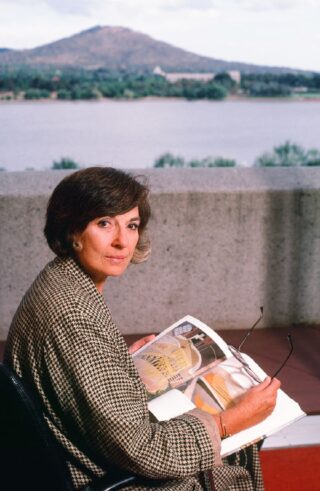- Entry type: Person
- Entry ID: AWE4846
Churcher, Betty
- AO, FAHA
- Cameron, Elizabeth Ann Dewar
‘Betty Blockbuster’

- Born 11 January 1931, Brisbane, Queensland, Australia
- Died 30 March 2015, Wamboin, New South Wales, Australia
- Occupation Art educator, Arts administrator, Director
Summary
Titles/ Honours
• 2012 ACT Senior Australian of the Year
• 2009 Australia Council’s $10,000 Visual Arts Emeritus Medal
• 2005 New South Wales Premier’s Award for Script Writing for the documentary series, The Art of War 2004-2005
• 2004 HonDUniv (Queensland University) 2004
• 2003 Honorary Fellow of the Australian Academy of the Humanities
• 2001 – Centenary Medal
• HonDLit (Curtin University)
• 1996: AO – Officer of the Order of Australia, in recognition of service to art and to the community as Director of the Australian National Gallery
• 1996 The Australian newspaper’s Australian of the Year
• 1996 HonLLD (ANU)
• 1995 HonDA (RMIT)
• 1990 AM – Member of the Order of Australia, in recognition of service to the arts, particularly in the field of arts administration and education
• 1988 Fulbright Scholar
Betty Churcher AO AM FAHA was director of the National Gallery of Australia in Canberra from 1990-1997 where she was nicknamed “Blockbuster Betty” because of the large-scale exhibitions of famous artworks she organised to make art relevant and accessible to the community. Betty Churcher has been a pioneer and role model for women in the art world: she was the first woman to head a tertiary institution when she was Dean of the Art and Design School, Phillip Institute of Technology (now RMIT University), the first female director of a state art gallery when appointed to the Art Gallery of Western Australia and the first female director of the National Gallery of Australia.
Details
Betty Churcher was born Elizabeth Ann Dewar Cameron, the second child and only daughter of Scottish-born William Dewar Cameron, and Queenslander Vida Margaret née Hutton. Churcher felt her mother and grandmother focused their attention on her older brother, making her acutely aware of the unfairness of gender differentials in her family during childhood. She cites this awareness as formative, saying that as a child she felt that ‘just about everything I wanted to do, I couldn’t because I was a girl’.
Feeling an outsider at her first school but born with the ability to draw, Churcher said of her time at Buranda State School
“my friends – could outrun, out-jump and out-spell me but they couldn’t out-draw me. Drawing was my way of creating order in a confusing world.” (Notebooks, p. 2)
She describes how she first had her eyes opened to art in 1939 when she was seven and her parents took her to the Queensland Art Gallery where she saw ‘Evicted’, an 1887 painting by Blandford Fletcher (http://qagoma.qld.gov.au/collection/international_art/blandford_fletcher):
“I really wanted to be able to do it. It was the magic of being able to evoke an image with such precision and full of … Emotion …It was as though the artist had opened up a glimpse of the past … as if time had parted …I marvelled that an artist had that power.” (Canberra Times, 1993)
The young Betty Cameron’s artistic talent was evident in her early years. She won The Sunday Mail Child Art Contest in 1944 and 3rd prize the following year. She initially studied art with Patricia Prentice at Somerville House School and later studied art privately with Caroline Barker and Richard Rodier Rivron.
A bequest from her maternal great-grandmother enabled Churcher to attend Somerville House, a private girls’ school in Brisbane from 1938-1946. Here she met Patricia Prentice, art teacher and watercolourist who introduced Churcher to art history, ballet and music and encouraged her to travel to broaden her horizons.
Churcher’s father had other plans; he decided there would be no more schooling for his daughter once she reached the age of fifteen, believing education ‘spoiled a girl’. Fortunately for Churcher, headmistress Frances Craig intervened. She encouraged William Cameron to allow his daughter to stay at school by offering to waive the fees if Churcher taught art in the junior school art. Cameron agreed and Churcher progressed to her senior year.
After finishing school, Churcher returned to Somerville House as a teacher of art and art history and also taught at two other private girls’ schools in Brisbane – Clayfield College and Moreton Bay College. She loved conveying her enthusiasm and passion. “That’s when I first felt the joy of being able to share an enthusiasm”.
She joined the Younger Artists Group of the Royal Queensland Art Society, along with future significant artists like Margaret Olley, Margaret Cilento, Peter Abraham, Harold Lane and Joy Roggenkamp. Churcher first exhibited with them in 1948 and was considered one of the most promising members. Her work was included in Queensland Art Gallery’s 1951 ‘Exhibition of Queensland Art’, and ‘Queensland Artists of Fame and Promise’.
As Chair of the Younger Artists Group, Churcher led the charge to establish a travelling art scholarship which she won, setting off for London in early 1952 where she initially studied with Stuart Ray at The South West Essex Technical College before gaining a place at the Royal College of Art. She won the Princess of Wales Scholarship for the best female student’s entrant portfolio and had three happy years at the Royal College from 1953-1956.
In London Churcher met and married Roy Churcher who was studying painting at the Slade School of Fine Art. Betty Churcher won the Royal College composition prize, graduated ARCA with a First Class pass, won the RCA Drawing Prize and the much coveted Travelling Scholarship which took her and Roy to Europe for three months.
In 1957 Betty and Roy Churcher returned to Brisbane for what was to be a brief visit to her parents but Roy fell in love with the place and they stayed, setting up a studio and giving classes. Although she painted and exhibited during that time, by the end of 1959 Churcher said the fire went out of her belly about painting and she gave it up. Unsure of her ability to be both a good mother and a good painter she said motherhood, which she loved, gave her ‘an out’. When her youngest son started school in 1971 Churcher took a full-time lecturing job at Kelvin Grove Teachers’ Training College, where she wrote her first book – “Understanding Art” – for which she won a Times Literary Award. She remained at Kelvin Grove for seven years, taking her husband and four sons to London for a one-year sabbatical during which she completed an MA at London University’s prestigious Courtauld Institute. Her thesis topic, that Alfred Barr’s exhibition policy at New York’s Museum of Modern Art in the 1930s and 1940s influenced the emerging school of Abstract Expressionist painters in New York, shaped her future career and gave her time at Museum of Modern Art (MoMA) and contact with the likes of Jackson Pollock’s widow – painter Lee Krasner, Robert Motherwell and Philip Gunson.
The Courtauld MA made her ‘hot property’ back in Australia and from 1979-1987 she taught at the School of Art and Design at Phillip Institute of Technology (now RMIT University, Melbourne) rising to become Dean in 1982.
In 1987 Churcher was headhunted by Robert Holmes à Court as Director of the Art Gallery of Western Australia. She had doubled attendance figures by late 1980 when she was invited to apply for the position of Director of the National Gallery of Australia (NGA) in Canberra after founding director James Mollison’s resignation. She was appointed by a selection panel headed by former Prime Minister, Gough Whitlam.
Churcher’s appointment was controversial and her first years at the National Gallery were made difficult by serious management and building maintenance problems and resistance from existing staff members to her directorship. Her arrival in February 1990 coincided with public service cuts and Churcher faced a budget slide into the red. Her program of cuts through voluntary redundancies was unwelcome and her decision to change the name from the Australian National Gallery to the National Gallery of Australia aroused more controversy. But in the face of all this, Churcher directed a number of highly successful major exhibitions that made significant profits for the Gallery and introduced the Australian public to works that had not previously been shown in Australia. Previously the National Gallery had accepted exhibitions from other institutions. Churcher set in motion the pattern of the Gallery compiling its own exhibitions, using their own curatorial skills and insights. The exhibitions included curator David Jaffé’s Rubens and The Italian Renaissance (1992) which made a profit of around $1 million, and Michael Lloyd’s Surrealism: Revolution by Night (1993), the first major surrealist exhibition to include Australian works.
After eight years, in July 1997, Churcher retired from the NGA and moved into another phase of professional life as presenter of television series on art including the ABC’s Take Five, Proud Possessors, The Art of War, Focus on John Olsen, The Hidden Treasures of the National Library and The Hidden Treasures of the National Library plus the SBS series, The Art of War.
In 1998 the Australian National University appointed her an adjunct professor at the Centre for Cross-Cultural Research.
Churcher lost the sight in her right eye to melanoma in 2003 and has lost some sight in her left eye as a result of macular degeneration. In 2006 she travelled to London and Madrid to commit to memory those pictures that she most wanted to hold in her mind’s eye before her sight further deteriorated. Out of this she produced her latest book “Notebooks”, featuring drawings and commentary on some of her favourite paintings. “Notebooks” was shortlisted for the 2012 Indie Awards for a non-fiction book.
Betty Churcher lived with her husband Roy in the NSW countryside near Canberra where their second son maintains the hobby vineyard on the banks of the Yass River. They had four children and seven grandchildren. She died on March 30, 2015.
Events
-
2001
Inducted into the Victorian Honour Roll of Women
Archival resources
- National Gallery of Australia, Research Library Archive
- National Library of Australia
- National Library of Australia, Oral History and Folklore Collection
Digital resources
Published resources
-
Resource
- Trove: Churcher, Betty (19310111-20150330), http://nla.gov.au/nla.party-459107
- Book
-
Resource Section
- Betty Churcher, 2011, http://www.daao.org.au/bio/betty-churcher/#artist_biography||
- Betty Churcher, 2005, http://www.abc.net.au/talkingheads/txt/s1450638.htm
- Giulia Jones, http://en.wikipedia.org/wiki/Giulia_Jones
- Betty Churcher, 2002, http://www.australianbiography.gov.au/subjects/churcher/bio.html
-
Newspaper Article
- Losing her sight but not passion, Schwartzkoff, Louise, 2009, http://www.smh.com.au/news/entertainment/arts/losing-her-sight-but-not-passion/2009/05/05/1241289168726.html
- Sunny surrealism, Usher, Robin, 2003, http://www.theage.com.au/articles/2003/12/15/1071336870848.html?from=storyrhs
- Double Take, 2008, http://www.theaustralian.com.au/news/features/double-take/story-e6frg8h6-1111116820437
-
Painting
- Evicted, Fletcher, Blandford, 1887, http://qagoma.qld.gov.au/collection/international_art/blandford_fletcher
-
Article
- Former director of National Gallery of Australia Betty Churcher dies aged 84, Prior, Sally, 2015, http://www.smh.com.au/entertainment/art-and-design/former-director-of-national-gallery-of-australia-betty-churcher-dies-aged-84-20150331-1mbppj.html
- Betty Churcher, cultural giant, loses battle with cancer, 2015, http://www.theaustralian.com.au/arts/betty-churcher-cultural-giant-loses-battle-with-cancer/story-e6frg8n6-1227285925257
-
Site Exhibition
- From Lady Denman to Katy Gallagher: A Century of Women's Contributions to Canberra, Australian Women's Archives Project, 2013, http://www.womenaustralia.info/exhib/ldkg
- The Encyclopedia of Women and Leadership in Twentieth-Century Australia, Smart, Judith and Swain, Shurlee (eds.), 2014, http://www.womenaustralia.info/leaders
